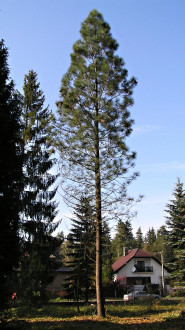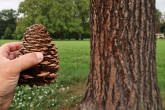(Pinus jeffreyi Grev. et Balf.)
Habitus
- tree growing to a height of 30 - 50 m
- crown is broadly conical to ovoid, relatively sparse
- branches grow in whorls, are thick, horizontal, they stand out and protrude at the ends
- the bark is grey-brown, relatively smooth for a long time
- the bark is split into larger rectangular layered plates gray-brown on the surface, reddish-brown inside
Shoots
- annual shoots are thick, greenish, bluish-colored
- in the second year they are greenish-brown with remains of brown
- branches smell of lemon oil when broken
Leaves (assimilation organs)
- needle-shaped leaves
- needles are 150 - 250 x 1.5 - 2.0 mm large, sharply pointed, triangular in cross-section, slightly serrated along the edges, bluish-green, firm, straight
- they are grouped in groups of 3 on brachyblasts (section Pinaster, subsection Taeda)
- they last 3-4 years on a twig
Flowers
- monoecious tree, flowers of different sexes, blooms in May
- ♂ cones are 2.0 - 3.0 x 0.8 x 1.1 cm large, oblong-ovoid, blunt, reddish-yellow, growing at the base of this year's shoot
- ♀ cones are 2.0 - 2.5 x 1.0 - 1.2 cm large, ovoid, red, later purple, erect to 2.0 - 2.5 cm long stem, they grow singly or 2-3 at the end of this year's shoots
Fruits – seeds
- the fruit is a cone 15 - 25 x 8 - 11 cm large, oblong-ovoid, reddish-brown, stalked
- the seed scales have cone-shaped cones with a point with a transverse ridge
- the umbilicus extends into a 3-4 mm long sharp point
- the seed is 10-12 x 7-8 mm large, oblong-ovoid, marbled with a pincer-shaped 2.5-3.0 cm long wing
Extension
- originally widespread in the western part of North America of the continent from southern Oregon to California
- grows on the slopes of the Sierra Nevada at altitudes of 1,600 to 2,700 m above sea level
- was introduced to Europe in 1852
Ecology
- it is a light-loving woody plant, undemanding to the content of nutrients in the soil and soil moisture
- it grows in areas with a wetter climate on soils less well supplied with nutrients
- forms homogeneous stands or stands mixed with fir (Abies noncolor)
- moderately resistant to low temperatures
Significance
- decorative tree with a habit (gives a massive impression, similar to the limbo pine)
- decorative with long, fan-shaped needles and large cones























